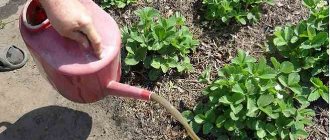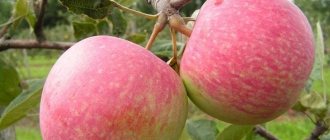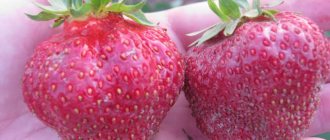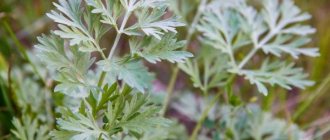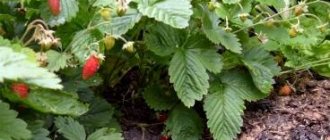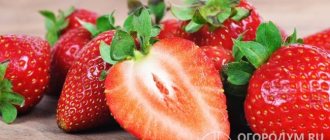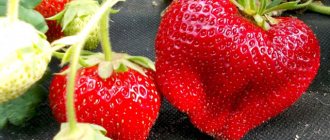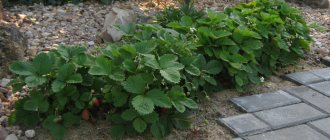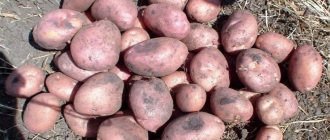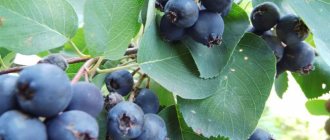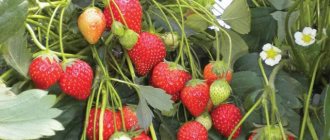Just 10 years ago, it was rare to find large-fruited remontant varieties of strawberries in garden plots and dachas. Today, the number of daylight neutral (day neutral) varieties is increasing simply exponentially. Domestic and foreign breeders are offering more and more new varieties that differ in taste, aroma, berry size and degree of resistance to climatic conditions, pests and diseases.
Albion strawberries belong to the strong middle class; they bear fruit in several waves, which allows harvesting from late spring to mid-autumn.
Description of the variety
The Albion variety is a hybrid native to America. It was created at the beginning of the 21st century by crossing the large-fruited varieties Diamante and Cal 94.16–1. The variety was bred specifically for industrial cultivation.
Botanical description
Brief botanical description:
- Bushes. Vigorous, well-leafed, reaching 40-45 cm in height. The peduncles are raised high and can hold a significant load. The fruits are raised above the ground - this reduces the likelihood of them being affected by rot. The leaves are medium sized, glossy, dark green in color. The bushes form few mustaches.
- Fruit. Large, slightly elongated. Conical shape. As they ripen, they become red and shiny. When ripe, the berries take on a pomegranate color. The pulp is juicy, pink, and quite dense.
- Flowers. Bisexual. Size – medium. White color.
Main characteristics
The Albion variety, in addition to the USA and southern Canada, is popular in Italy and the Russian Federation. In central Russia, it is rarely grown in open ground - usually in greenhouse conditions, with good lighting. The hybrid is not included in the State Register of the Russian Federation.
Main agrotechnical indicators:
| Characteristics/parameters | Description/meaning |
| Fruiting | remontant variety, 4 harvests are collected |
| Beginning of flowering | May |
| Ripening time | early ripening |
| Average weight of berries | 40-50 g or 35-45 t/ha |
| Productivity | 0.5-2 kg per bush |
| Taste | sweet, sour |
| Aroma | rich strawberry |
| Tasting score | 3,5-4,5 |
| Frost resistance | low |
Albion has fruits of the same size. They have a peculiarity - the shape of the berries can change by the third or fourth fruiting. For example, from conical to heart-shaped or oval.
The gardener made a video review of Albion strawberries, where he weighed and gave a description of the properties of this variety:
Advantages and disadvantages of the variety
Pros:
- It grows and forms ovaries continuously. In the middle zone - from May to October. If you grow the variety under cover, it bears fruit almost continuously.
- The fruits are one-dimensional, without voids.
- Continuity of fruiting. This remontant variety, having given its first harvest in May, continues to bear fruit in waves until September.
- Good shelf life and transportability are natural for an industrial grade. The berries withstand transportation well - they do not wrinkle, maintaining marketability.
- Disease resistance. Albion is resistant to heart rot and all fungal infections.
- Ecological purity of berries. Due to its resistance to fungi, the variety can do without chemical treatment.
The disadvantages are rather characteristics of the variety:
- The taste is affected by growing conditions. Ideally, the berries are sweet, but in unfavorable climates they are sweet and sour.
- Fruiting begins only in the second year of planting.
- Weather conditions and care affect the volume of the harvest.
- Affected by spotting - brown and white.
- After 3 years, the plantings are renewed.
- In temperate climates it freezes if you do not use insulation.
History and description of Albion strawberries
The remontant variety Albion appeared in 2006 thanks to the work of Californian scientists. The strawberries were obtained by crossing the Diamante and Cal 94.16–1 varieties and were intended for commercial cultivation. Initially, the new hybrid was called CN220.
Albion is a day neutral variety. It is recommended for cultivation in the USA, Italy, and southern Canada. In the Russian Federation, cultivation of this variety gives the best results in the southern regions (Crimea, Krasnodar Territory, Rostov Region). In the middle zone and northern regions it cannot be grown in open ground, but it bears fruit well in greenhouses provided there is high-quality lighting.
The variety blooms and forms ovaries continuously (in Russian conditions - from early May to October). When grown in greenhouses, you can get a harvest all year round. It begins to bear fruit in the second year after planting.
Preparation and planting
Albion in the southern regions is planted mainly in late summer or early September. Then the first harvest is harvested next year. When planting seedlings in the spring, they wait longer for the harvest. Read about how to properly plant strawberries in spring here.
In autumn, seedlings are planted a month before the onset of persistent frosts. In temperate climates, autumn planting is not advisable. The variety does not tolerate severe frosts, and it is not advisable to plant it before winter. In the central regions, spring planting is practiced. It begins when the soil warms up to +15 °C. The tendrils and peduncles of seedlings planted in the spring are cut off as they grow - so that the plant does not waste energy on reproduction and fruiting, but forms a powerful root system.
Requirements
The variety was bred for a mild climate with warm winters, so Russian frosts turn out to be destructive for it. Albion grows well in the south of the country - in the Krasnodar Territory, Crimea, and the North Caucasus. In the middle zone, the variety is grown in a greenhouse, or carefully insulated for the winter - but there is no guarantee that the bushes will not freeze.
For planting Albion, choose well-lit, level areas with good drainage. The variety grows well on any soil, but prefers fertile loams with a weak or neutral reaction.
Soil preparation
The soil is prepared 3-4 weeks before planting seedlings. The task is to remove all weeds - its above-ground and underground parts, and increase soil fertility.
For 1 sq. m of soil prepared for planting Albion seedlings, add:
- superphosphate – 70 g;
- potassium sulfate – 30 g;
- ammonium nitrate – 30 g;
- humus - 2-2.5 buckets.
Having scattered the fertilizers, the soil is dug up onto the bayonet of the shovel. If planting is carried out on beds, they are formed. The standard height of strawberry beds is 25-30 cm. The beds are not required; they are usually made when there is stagnation of water in the area.
The beds are prepared a week before planting the seedlings so that the soil has time to settle. Albion bushes are large, they need space to grow, so the interval between adjacent beds is at least 45 cm.
Selection and preparation of planting material
For a good harvest you need healthy seedlings.
You can distinguish high-quality seedlings by the following characteristics:
- powerful roots;
- root collar with a diameter of 6 mm;
- The seedlings must have a strong and healthy appearance - no dryness or defects.
Preparing seedlings for planting:
- shorten excessively long roots - their length should not exceed 8-10 cm;
- tear off excess leaves - when planting there should be no more than three;
- place the roots in a growth stimulator for a day.
Experienced gardeners recommend keeping seedlings for 6 days in darkness and coolness before planting.
Further care for Albion strawberries
Albion strawberries require special care, without which it is unlikely that it will be possible to obtain good yields from this variety.
Irrigation regime
The most important thing when caring for this strawberry bushes is compliance with the watering regime.
. This plant requires regular, abundant watering, which is done every day in the morning or evening in dry weather. It is advisable to arrange drip irrigation for this strawberry plantation; in this case, gardeners will get rid of the need to water this crop manually every day.
It is especially important to observe the irrigation regime during the period of flowering and berry formation. During these periods, at least 2-2.5 buckets of filtered heated water are required for each square of area.
Important!
You cannot water Albion strawberries with cold water; such watering can provoke the development of root rot.
It is also necessary to control soil moisture, since excess moisture causes watery berries, and with a lack of water, the bushes wither and voids form in the fruits.
Top dressing
Albion strawberries respond well to the application of organic matter and mineral fertilizers
. Since the bushes bear fruit several times a season, they are greatly depleted. Therefore, they are regularly fed with organic and mineral fertilizers throughout the season.
Rotted mullein, humus or humus are used as fertilizers. In April, wood ash is added to organic matter, and during the summer season complex mineral fertilizers are used to feed Albion strawberries.
During the period of budding and active formation of ovaries, feeding should be carried out “by leaf”. They must include preparations containing iron. You can also feed the bushes with a solution of boric acid once during the summer season to increase productivity.
Loosening procedure and weed removal
Strawberry beds are loosened regularly. This procedure improves the looseness of the soil, as a result, moisture and oxygen enter the soil better. It is best to loosen the soil immediately before watering, and then mulch the beds with a layer of straw or sawdust.
Also, when loosening, you should remove all weeds that can clog the strawberries and take away from the soil the nutrients necessary for the growth of garden strawberries and the ripening of fruits.
Preparing for winter
Albion strawberries are prepared for winter in several stages:
- in early September, the soil around the bushes is deeply loosened, going 4-6 cm deep;
- after harvesting the last harvest, a layer of mulch 4-6 cm thick is added to the beds. Straw, sawdust or peat can be used as mulching material;
- in early or mid-November (depending on the climatic conditions of the growing region), the strawberry plantation is covered with spruce branches;
- after snow falls, a layer of straw or manure is laid on top of the spruce branches.
As soon as the snow melts in the spring, the shelter must be removed.
How to cover strawberries for the winter - video
Albion planting methods
The procedure for planting seedlings in open ground:
- On a flat area or in prepared beds, prepare holes for planting. Their depth should be such that the roots of the seedlings fit comfortably in them - without curling up or bending. Recommended hole layout:
- between neighboring bushes - 30 cm;
- between rows – 40 cm.
- Throw a handful of humus into the hole. Pour in 200 ml of warm water. And add a teaspoon of ash.
- If film is used when planting, make cuts in the right places. The film simplifies the care of strawberries - it retains soil moisture, and there is no need for regular weeding.
- Place the seedling in the hole, spreading out the roots. Sprinkle them with soil and tamp them down gently with your hands. Pay attention to the growing point - it should not be buried in the soil; the ideal location is exactly at ground level.
- If there is bright sun outside, shade the beds for several days using agrofibre or straw.
Other Albion growing methods:
- Dutch. Each bush is planted in containers, boxes or pallets filled with a special substrate. With this technology, there is no contact between the fruit and the soil, so the berries avoid many diseases and retain their marketable appearance. The method ensures continuous productivity; seedlings are planted regularly - every 1.5-2 months. The Dutch method requires special soil - low-acid soil is mixed with sand, ash, sawdust, compost, and urea is added.
- Hydroponic. Used in regions with clay and marshy soils. This method is based on growing plants without soil. Plants receive everything they need for life along with nutrient solutions - they are prepared specifically for a specific variety and growth period. The method allows you to accelerate the development of plants and increase their productivity, eliminates loosening, pests and diseases. Care is greatly simplified, and productivity increases. There are several options for hydroponics, the following are suitable for strawberries: Periodic flooding system - suitable for large strawberry plantings. A well-established system for supplying nutrient solutions is used.
- Nutrient layer – in the installations used, beneficial substances constantly circulate along the bottom of containers with strawberries. The bushes themselves are located in cups. Growing up, the roots of the plant are immersed in the solution, receiving nutrition.
Characteristics of the variety
The main advantage of the Albion strawberry variety is the ability to harvest from May to October.
Advantages of the variety
- large fruit;
- good shelf life and the ability to maintain its presentation for a long time;
- a small number of mustaches;
- high immunity to most diseases of berry crops, so the variety can be grown without chemicals;
- drought resistance;
- possibility of growing indoors (self-pollinating);
- easy propagation in several ways;
- high yield.
Disadvantages of the variety
- does not tolerate extreme heat (needs shading in southern regions);
- There may be voids inside the fruit due to improper cultivation techniques;
- often chlorositis;
- There are reviews about mediocre taste and very dense pulp.
Growing and care
One of the advantages of modern industrial varieties is high yield with a minimum of care. Albion is one of those - it doesn’t require anything unusual, just watering and fertilizing. Other activities depend on the growing method
Watering and fertilizing
Water Albion as soon as the soil dries out. Over-watering is unacceptable - the bushes may die. Lack of water is no less harmful - because of this, berries lose their taste and quality. Watering frequency is once every 5 days. The best watering option is drip irrigation.
Albion has to spend a lot of effort - to produce 4 crops per season, additional food is required. Both groups of fertilizers are applied - organic and mineral.
The variety is responsive to fertilizing from:
- cow dung;
- bird droppings.
Humus and compost are added under the roots - they also act as mulch. In spring, mulch is added to organic fertilizers; in summer, plantings are enriched with complex fertilizers.
Fertilizing is applied three times:
- Early spring. Water under the root with diluted urea, 1 tbsp per bucket of water. l. Find out more about spring feeding here.
- Before flowering. Water with potassium sulfate (1 tsp per 10 l).
- Autumn. For 10 l - 2 tbsp. l. nitrophoska and a glass of ash.
Mulching
To retain moisture in the soil longer, it is mulched with sawdust, hay, and straw. If agrofibre or other mulch is not used when growing strawberries, the soil must be loosened to remove weeds.
Mulch not only retains moisture, it has several other important advantages:
- eliminates the need for regular weeding and loosening;
- protects bushes from overheating;
- prevents the berries from coming into contact with the ground - this avoids spoilage and contamination of the fruit.
Learn more about soil mulching by reading this article.
Care
Remontant varieties are characterized by rapid depletion, so it is necessary to regularly loosen the soil near the bush, but this must be done carefully, not allowing the roots to become exposed. To grow tasty berries, the plant needs to be watered abundantly; the ideal option would be to install a drip irrigation system.
From late spring to early autumn, the plant produces numerous tendrils, which, after rooting, form new bushes. They do not require pruning. But pruning is still necessary for young plants to improve the development process. Old plants are pruned if there are injured areas.
Strawberries are fed 2-3 times a month with mineral fertilizers. Fertilizing is carried out during the flowering period and during the formation of ovaries.
In order for the plant to overwinter, before the onset of frost, the bushes are covered with fallen leaves, humus or straw. It is advisable to avoid covering strawberries with film, since there is a high probability of fungi appearing.
Reproduction
Intensive fruiting quickly ages strawberries, yields drop, and the quality of the berries suffers. It is necessary to regularly update the plantings. Seedlings are purchased from nurseries, or they make do with their own, taken from the mother bushes.
Albion seedlings are not cheap, so gardeners try to propagate them themselves. Of the three methods of propagation - seeds, dividing the bush, mustaches. The first two options are most often used.
Reproduction methods:
- Usami. Albion bushes produce few tendrils, and in order to get enough of them, all flower stalks are cut off on the mother bush. The first rosettes from the mother bush are cut off and planted near the mother bush - at a distance of 30 cm. All the rest are planted in a nursery. In the first year of life, plants should not bear fruit, and all flower stalks are torn off - this way the plants take root better
- Dividing the bush. This is the simplest and most reliable way. But only 4-5 year old plants are taken for it.
- Seeds. They are taken from ripe berries. The seeds are kept in rain/melt water for a couple of days - it is replaced 2 times a day. Sow the seeds in a nutritious soil mixture. This labor-intensive method does not guarantee that the seedlings will bear Albion varietal characteristics.
Advantages of the variety
The main advantages of Albion strawberries include:
- good yield in suitable climatic conditions and compliance with all care rules. Moreover, in greenhouse conditions it is possible to harvest crops from these strawberries all year round;
- beautiful presentation and excellent taste of ripe fruits;
- the ability to transport the harvested crop over different distances, and their presentation and taste do not deteriorate;
- resistance to certain diseases;
- This variety is remontant, so it is possible to collect several harvests from each bush per season.
Diseases and pests
Albion needs preventative treatment. First, after the snow melts, and then after flowering, the plants are sprayed with fungicides. Spraying with a soap-iodine solution is useful - dilute 30 drops of iodine and 40 g of laundry soap in a bucket of water.
To protect strawberries from pests, plantings are sprayed - for preventive or therapeutic purposes - with the following preparations:
- Colloidal sulfur (per 10 l – 60 g) – against strawberry mite.
- Ash or metaldehyde (3-4 g/m) – against slugs. They pollinate plantings twice - before flowering and after harvesting.
- Insecticide BI-58 – against nematodes. The best option is to tear out the affected bushes by the roots and burn them.
Gardeners recommend:
- To prevent powdery mildew, rot, white and brown spots, spray the plantings before flowering with Topaz - dilute one ampoule in 10 liters.
- When slugs appear, make traps. Take a jar with smooth edges and dig it in so that the neck of the container is flush with the ground. If you pour beer into it, the slugs will fall into the jar and drown.
- If the area is being attacked by wasps, make a trap. Cut the plastic bottle - cut out the middle. You should end up with two parts - top and bottom. Insert the top into the bottom and turn the neck down. Pour kvass or jam into the trap and place it on the garden bed. Once the wasps are trapped, they will never get out.
Such simple methods will help save the crop without the use of pesticides.
Features of cultivation
Although strawberries are not too demanding, to obtain good harvests they need regular care - watering, fertilizing, weeding, protection from pests.
Recent Entries
5 working ways to use tar in the garden 7 indoor plants that help you get married even in adulthood Indoor plants that can bloom in trouble
Watering, fertilizing and soil care
Albion strawberries react negatively to lack of moisture - the quality of the berries deteriorates, and voids may appear in them. At the same time, excessive watering also causes harm, causing decay. Therefore, you need to water regularly (every 12–14 days), but in moderation. Before flowering, it is recommended to water by sprinkling, then along the furrows. But the best way is drip irrigation, since the water goes directly to the roots.
Drip irrigation system pipes are laid during the arrangement of beds
The soil also needs regular care. After each watering, it is necessary to pluck out the weeds and destroy the soil crust by loosening (10–15 cm between the rows and 2–3 cm near the bushes). You can save yourself from this tedious work if you grow strawberries under a black film, but we must not forget that it sometimes provokes the spread of fungal diseases.
To increase the yield of remontant strawberries, it is recommended to remove flower stalks in the first wave of fruiting. This method allows you to significantly increase the yields of subsequent harvests.
For remontant strawberries of any variety, regular feeding is very important, since the plant is constantly forming a harvest. The best fertilizer is organic matter - solutions of mullein or bird droppings, compost, manure. It is recommended to feed strawberries with liquid solutions every 2–3 weeks.
Mineral fertilizers are applied 3 times during the growing season:
- At the beginning of the regrowth of young leaves, add 0.5 liters of urea solution (1 tablespoon per bucket of water) per bush or 50 g/m2 of nitrophoska.
- Before flowering begins, feed the plants with 2 tbsp. l. nitroammofoski and 1 tsp. potassium sulfate per bucket of water (0.5 liters per 1 bush).
- In the fall, after fruiting has ended, add 1 liter per plant of a solution of 10 liters of water with the addition of nitrophoska (2 tablespoons) and wood ash (1 glass).
Doses of fertilizers cannot be exceeded - the plant begins to increase green mass to the detriment of the harvest.
Strawberries respond well to foliar feeding:
- In the spring, when the leaves grow, spray with a 0.1% solution of manganese sulfate, a 0.1% solution of boric acid, and a 0.05% solution of ammonium molybdic acid.
- In August, it is useful to carry out foliar fertilizing with urea (0.3%).
An important component of strawberry foliar feeding is manganese sulfate.
Protection from diseases and pests
Despite good resistance to most diseases, preventive treatments will be useful. In particular, it is recommended to use Fitosporin or Glyokladin after snowmelt, and then during flowering. You can also increase resistance to diseases using a soap-iodine solution (30 drops of iodine and 35–40 g of laundry soap per bucket of water).
To protect against pests, preventive or curative treatments will be required:
- You can get rid of strawberry mites using a solution of colloidal sulfur (55–60 g per bucket of water).
- Pollination with ash or metaldehyde (3–4 g/m2) before flowering and after harvest will help against slugs.
- Nematodes can be treated with strong insecticides (Dinadim, BI-58). Better yet, destroy the infected bushes. If the cuttings become short and deformed, and the leaf blades are curled, you need to dig up the bush with its roots and burn it.
Strawberry pests in the photo
The mite eats young leaves, they wrinkle and the berries become smaller
Slugs are especially active in wet weather; they penetrate berries, gnawing holes in them
Plants affected by the strawberry nematode are stunted in growth, turn yellow, their leaves are deformed and their fruits become smaller.
Preparing for winter
At the beginning of autumn you need to start preparing strawberries for wintering:
- In September, loosen the soil two or three times to a depth of 5 cm.
- In October, after harvesting the last harvest, mulch the plantings with a 5-centimeter layer of peat or sawdust.
- In November, additionally cover the beds with spruce branches. If the winter turns out to be snowless, then another layer of straw or rotted manure is poured on top of the spruce branches.
Growing strawberries in flower pots and hydroponics
In addition to cultivation in open ground and in greenhouses, there are other methods. Like other remontant varieties, Albion can be grown at home. Each bush is planted in a regular flower pot with a volume of at least 3 liters. The soil must be nutritious and, in addition, to ensure constant fruiting, you will need to feed the strawberries with solutions of organic and mineral fertilizers every two to three weeks.
Strawberries grown in a pot on the windowsill will delight you with berries in winter
Another option for growing Albion strawberries, suitable for both industrial and home use, is hydroponics cultivation. This means planting strawberries in containers filled with expanded clay or coconut fiber instead of soil. To ensure the growth, development and fruiting of plants, the substrate must be kept moist, and all the necessary nutrients are added to the irrigation water.
In hydroponics, with drip irrigation, strawberries develop and bear fruit well
When and how to harvest?
If Albion grows in open ground, it usually produces 4 harvests. Periods of mass ripening of berries:
- the end of May;
- early July;
- mid-August;
- in the second half of September.
How to pick berries:
- It is recommended to pick berries when they reach full ripeness. Unripe berries will not gain any sweetness.
- Harvesting is done by hand.
- The best time to pick berries is morning or evening. Collection - in dry weather.
- The berries are torn off along with the stalk and immediately placed in a container for transportation.
Albion berries, unlike other varieties, can be stacked on top of each other - in a thick layer. They do not wrinkle and do not leak juice.
How to collect and preserve the harvest
Garden strawberries are one of the most perishable berries. Harvesting and preserving a harvest is a whole science; it’s not without reason that many gardeners ask this question: not only experienced ones, but also beginners. Albion strawberries are a remontant variety that bears fruit throughout the season, so they need to be collected regularly.
If you do not plan to serve the berries immediately, and you need to store them for some time, then it is recommended to start picking approximately two days before full ripeness, when the berries are still pinkish. In this case, they can be stored in the refrigerator for 2-3 days. Remove the berries intended for transportation, along with the sepals and small tails. Do this in the morning, but after the dew has dried.
The berry is best eaten immediately after picking.
Place the harvested strawberries in plastic boxes lined with soft cotton cloth; gauze is perfect for this. To prevent the fruits from softening during transportation, lay the strawberries in one layer. Cool the harvested crop 0…+2°C. Try to do this as soon as possible after harvesting; chilled fruits can last in the refrigerator for up to 3 days. For cold storage, use containers with vacuum sealed lids, or glass jars can also be used for this purpose. Before storing, do not sort or wash the strawberries.
Blast freezing will help keep strawberries fresh for a long time. Place clean berries on a plate and place in the freezer. When they harden, place them in a plastic bag or plastic container. This way, the strawberries won't stick together and you can get exactly as many berries as you need to consume at one time.
Application of fruits
Albion berries are eaten fresh and used for making jam and compotes - the fruits are dense and do not lose their shape. Like any strawberry, Albion finds application not only in cooking, its berries:
- improve metabolism;
- have a diuretic and diaphoretic effect;
- decoctions and infusions of strawberries are useful for stomatitis and pharyngitis;
- infusion of leaves is indicated for high blood pressure, stops bleeding;
- Root decoctions are used for hemorrhoids and colitis.
Strawberry Albion: reviews from gardeners about the variety
However, healthy berries have special excellent taste properties, which receive a huge number of positive reviews about Albion strawberries from gardeners. Summer residents note that they are tasty, sweet, fragrant, and give off an unusual fresh strawberry aroma. Due to the fact that the berries have a high level of density, they are suitable for storage for a long time, and also tolerate transportation quite calmly, which, undoubtedly, is a huge advantage for them.
Reviews about strawberries
Gardeners who tried the Albion variety on their plots left reviews in which they noted both the advantages and serious disadvantages of the variety.
Positive points:
- excellent taste;
- good tolerance to long-term transportation;
- long fruiting.
Noticed shortcomings:
- average disease resistance;
- demands on care and climate.
The variety is industrial, and what seems simple for mass cultivation can be difficult for amateurs. For example, the variety grows well using the hydroponic method - the growing process is almost automated. If you take care of Albion manually, you have to spend the whole summer running around with hoses and fertilizers.
★★★★★
Valery R., Belorechensk. The variety is not always as productive as we would like - it requires good care.
The first berries do not meet the stated characteristics - they are sour. But then the real sweetness begins. In terms of productivity, the variety is clearly inferior to Queen Elizabeth, but it still produces a lot of berries. ★★★★★
Arseniy R., Moscow region. Albion is attracted by prolonged fruiting.
Strawberries produce berries all summer long and even take over some of the fall. True, you have to grow it in a greenhouse - the seedlings planted in open ground froze a little in the winter, despite the insulation. Hide
Add your review
Albion can seriously compete with the best commercial varieties. Gardeners claim that it has no equal in terms of keeping quality and transportability, and its yield justifies all the costs invested in cultivation. Ordinary amateur gardeners are attracted to this industrial variety by the long fruiting and excellent taste of the berries.
0
0
Copy link
Reviews
I said goodbye to Albion. First of all, there is no taste. The berry is beautiful, but impossible to eat. Secondly, it bears fruit normally only for one year. Already in the second season the bushes are somehow tortured and practically do not produce flower stalks. In addition, chlorositis is common. When there was chlorosis, I poured urea (30 g per bucket and a liter per bush), it helped, but not all the bushes, some fell out.
Those who write that Albion is sour and soft - “You just don’t know how to cook it.” But seriously, you should wait for the burgundy color of the berries. Red berries are technically ripe, they can be picked, but then you have to keep them at home for a couple of days and they will “arrive”, but it’s better to keep them right on the bush. Here is a burgundy berry that is tasty and aromatic and less dense. And density cannot be regarded as a disadvantage; “Albion” is used by many as an industrial grade, and therefore must keep its shape during long-term storage and transportation.
A good harvest of Albion strawberries can be obtained with a minimum of agrotechnical measures. For fruit growth and formation, you need soil high in nutrients, moderate watering and regular inspection for diseases and pests.
Growing regions
The culture grows well in France, Italy, Spain, and in the southern regions of Russia. In the southern United States and Canada, Albion strawberries are grown on an industrial scale.
When breeding in cold regions - Northern Europe, Poland, Belarus, Ukraine, Russia, etc., the characteristics of the variety may change. The fruits are less sweet and smaller in size.
For cultivation in temperate latitudes, it is recommended to plant the crop in greenhouses.
The variety does not tolerate frost well. Without additional shelter, strawberries may die when the temperature drops to -10˚C
Features of care
Watering and fertilizing
Albion strawberries, like other varieties, are demanding when it comes to watering. The frequency of moistening the soil depends on the weather, mulch and other conditions, but it is important to keep the soil moist at all times. Plants are especially sensitive to watering during flowering and fruit set; there is no way to save money here.
For a good harvest, Albion requires fertilizing. If the land was well-dressed before planting, then phosphorus-potassium fertilizers are not applied in the first year. After picking the berries, at the end of summer, you can add autumn Gumi-Omi at the rate of 100 g per 1 m2 of planting.
Table: timing of fertilizer application starting from the second year
| Fertilizer application period | Type of feeding | Quantity |
| Spring Summer | Gumi-Omi berry | 70 g per 1 m2 |
| Autumn | phosphorus-potassium | 30 g superphosphate + 10 g potassium sulfate |
| Gumi-Omi autumn | 100 g per 1 m2 |
Video: description of the Albion variety
Characteristics of Albion berries
Albion berries grow large, weighing 50-60 g. In the first wave of the harvest, the berries are one-dimensional, in the rest the fruits become smaller, their dimensions can be different.
The shape of the fruit is conical. The surface is bright carmine color, glossy, smooth. The berries begin to ripen from the tip. Often there are fruits with a light red color near the calyx.
Albion strawberries
In cross-section, the strawberry is deep pink in color, without voids. The taste is sweet and sour, and under favorable growing conditions and weather conditions, the acid is completely absent. The strawberry aroma is pronounced.
The pulp of Albion strawberries is very dense, but at the same time tender when consumed. Picked berries remain fresh for a long time, do not leak or wrinkle. Albion's transport properties are among the highest among other strawberry varieties. This feature of strawberries allows them to be successfully used for growing for commercial purposes.
The berries are used frozen, fresh and for processing. Thanks to their dense pulp, when cooking preserves, jams, compotes, Albion berries do not become soft and retain their shape.
Landing
Since Albion is a remontant variety and bears fruit in the spring, it is preferable to plant it in late August - mid-September.
- Planting strawberries should begin by choosing a place - the lightest area in the garden. When digging, add organic matter - compost or rotted manure and ash at the rate of 100 g per 1 m2 or 30 g of superphosphate and 10 g of calcium chloride.
- Select strong seedlings with a good root system for planting, remove all flower stalks from them and place them in a dark, damp place for 5–6 days.
- Immediately before planting, soak for an hour in a solution of phytosporin (1 tsp solution per 10 liters of water).
It is advisable to plant strawberries in cloudy weather or in the evening.
- Dig holes in the prepared bed, taking into account that Albion bushes are large and will need space for good development and fruiting. The best results are obtained by the single-row growing method, with the distance between holes being 25–30 cm and between rows 60–70 cm.
- Make a mound in the hole, place a strawberry seedling on it and straighten the roots cut to 7–8 cm. Strawberry roots should not bend upward - this is an important condition for successful planting.
- Sprinkle the bush with fertile soil, being careful not to bury the “heart” - the central part of the plant; water well. If the weather is warm and sunny, it is advisable to shade the young plantings for several days.
- Planted strawberries must be mulched - this will protect the soil from drying out and compacting. Preference should be given to pine needles, but you can also use straw, dried mown grass, and rotted sawdust.
Albion strawberries, like many other varieties, grow and develop well in beds covered with agrofibre. At the same time, small crosswise cuts are made on the dark fabric according to the location of the holes. Seedlings are planted in these slots.
Albion grows well on agrofibre
Many gardeners fell in love with this method of planting, appreciating the savings in effort and time in caring for the berries. Strawberries grown on agrofibre do not need to be weeded, since the weeds do not break through the dense fabric, plus savings on watering, because the moisture in such beds evaporates very slowly. Well, a bonus - the berries are always clean, even after the heaviest rain.
Main characteristics
Strawberry bushes are quite powerful and spreading. The leaves are wide and have teeth along the edges. It is slightly wrinkled and dark green in color. Peduncles are strong and erect. When the fruits set, the flower stalks do not bend to the ground.
The variety is considered remontant. Fruit buds appear under neutral day conditions. Flowering and formation of berries continues continuously. The highest yield can be obtained in late spring or early summer, as well as in mid-August and towards the end of September.
The variety's resistance to cold is extremely low. Freezing occurs already at -10 degrees. If the crop is grown in beds, then it should be carefully covered for the winter. In summer she is also capricious about the weather. When the temperature exceeds 30 degrees, fruit formation may stop. The process will continue only after normal temperature has been established. Albion also does not like rain, this makes the strawberries watery.
Fruiting begins a year after the plant is planted in a permanent place. If you plant young bushes in the fall, they will bear fruit by spring.
Good productivity lasts for 3-4 years. Then you need to plant new strawberries.
Strawberries or wild strawberries
Amateur gardeners often call this berry strawberry, but its correct name is garden strawberry.
Juicy, beautiful, sweet berries with an amazing aroma are good fresh, frozen, or canned. Compotes, jams, confitures, jams, opened in winter, will definitely remind you of sunny summer.
There are a huge number of types of strawberries, but breeders work tirelessly to improve and develop new varieties.
Large beautiful berries
In 2006, scientists at the University of California, USA, developed a new variety of remontant strawberry - Albion.
